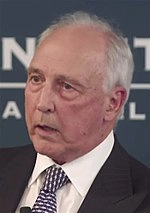How to Pronounce Paul Keating
#50
Most Popular
Boost
Jan 18, 1944 Bankstown, New South Wales, Australia 80 years old
Australian politician, 24th Prime Minister of Australia
CapricornPaul Keating, Date of Birth, Place of Birth, Family, Facts, Age, Net Worth, Biography and More in FamedBorn.com

Australian politician, 24th Prime Minister of Australia
Capricorn